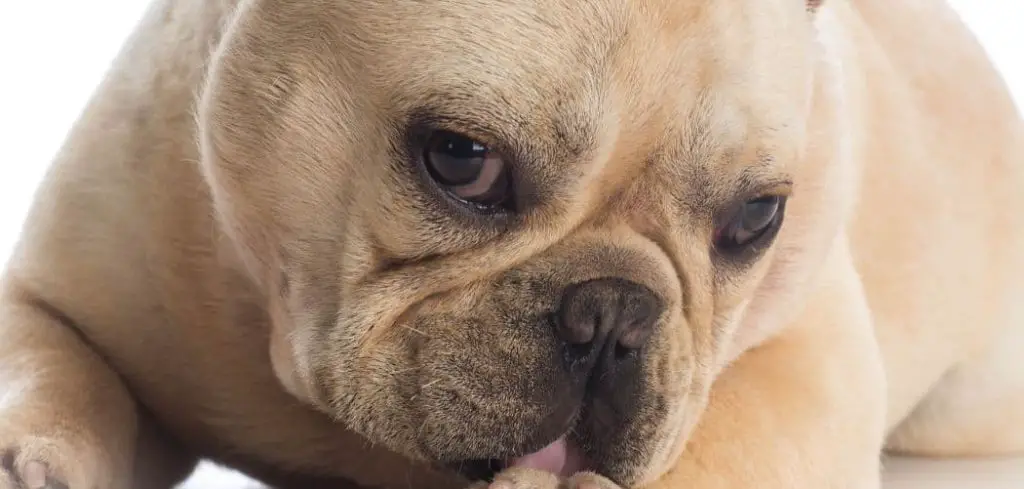Dogs that are excessively licking and drinking more than usual can be showing early warning signs of an underlying health issue.
While it may start as a mild behavioral change, it often points to medical problems that need attention.
We outline the common reasons why a dog may excessively lick and drink water, what you can do at home, and when to seek veterinary help.
Dog Excessively Licking and Drinking — Why It Happens
When a dog begins licking excessively while also drinking large amounts of water, it can signal both physical and behavioral concerns. These symptoms may stem from conditions like allergies, gastrointestinal irritation, liver or kidney disease, or even stress-related behaviors.
Hormonal disorders such as Cushing’s disease can also contribute to increased thirst alongside repetitive licking.
Sometimes, a dog may lick as a self-soothing mechanism if they feel unwell, while the excessive drinking reflects an internal imbalance.

Excessive Licking and Drinking in Dogs: Common Causes
Allergies and Skin Irritation
Allergies are a frequent cause of excessive licking in dogs. When the skin itches due to food sensitivities, flea bites, or environmental allergens, dogs often lick themselves for relief.
The irritation can drive them to lick constantly, which may cause further redness and infection. Alongside this, some dogs with allergies develop increased thirst due to inflammation or secondary infections.
Owners often notice red patches, paw licking, or hot spots in addition to drinking more water than usual.
Read more: Dog Excessive Licking and Shaking (Why it happens)
Gastrointestinal Problems
Dogs sometimes lick excessively when they have nausea or stomach upset. The licking is a way to soothe themselves or because they are experiencing reflux or discomfort.
In cases of GI irritation, dogs may also drink more water in an attempt to ease the burning sensation or replace fluids lost if vomiting or diarrhea occurs.
Signs can include drooling, gagging, grass eating, and restlessness paired with unusual thirst.
Kidney Disease
Kidney disease is one of the most common medical conditions that cause a dog to drink excessively.
As the kidneys lose their ability to filter waste properly, dogs drink more water in an attempt to flush toxins from the body.
Excessive licking may develop as a stress response or due to nausea associated with toxin buildup in the bloodstream.
Other signs include weight loss, decreased appetite, vomiting, and lethargy. Kidney disease can progress quickly if untreated, so early detection is critical.
Liver Disease
The liver plays a vital role in metabolism and toxin removal. When liver function declines, dogs may feel unwell and show abnormal behaviors like licking floors, walls, or their own paws.
At the same time, they may drink excessively as the body struggles with metabolic waste.
Owners often notice yellowing of the gums or eyes (jaundice), vomiting, or general weakness. Because the liver has many essential roles, disease in this organ is always serious and requires veterinary attention.
Cushing’s Disease (Hyperadrenocorticism)
Cushing’s disease is caused by an overproduction of cortisol, a stress hormone, in the body. Dogs with this condition commonly display excessive thirst (polydipsia) along with increased urination.
The hormonal imbalance can also cause dogs to develop compulsive licking behaviors. Signs may include hair loss, a pot-bellied appearance, panting, and skin thinning. Cushing’s disease is more common in older dogs but can affect younger ones as well.
Stress and Anxiety
Not all causes are strictly medical. Dogs under stress or experiencing anxiety may lick excessively as a form of self-soothing. This behavior is sometimes compared to nail-biting in humans.
Stress can also increase water consumption in some dogs. Changes in environment, loud noises, or separation from family members can trigger this cycle.
If no medical issues are found, behavioral support may be necessary to address anxiety-driven licking and drinking.
What to Do If Your Dog Is Excessively Licking and Drinking
When noticing these symptoms, the first step is to carefully observe patterns. Note how often your dog licks, when they drink, and whether other symptoms like vomiting, lethargy, or appetite loss are present.
At home, ensure your dog has constant access to fresh water, as restricting water can be dangerous. Keep their environment calm and reduce stressors if anxiety seems to be a factor. Check their skin and coat regularly for redness, bumps, or fleas that may be contributing to licking.
Dietary adjustments can sometimes help if food sensitivities are suspected. Switching to a high-quality, limited-ingredient diet may reduce allergic triggers. Grooming and regular flea prevention are also essential.
However, home care can only go so far. Because many medical issues tied to these symptoms are serious, scheduling a veterinary check-up is always the safest step.
When to Call or Visit Your Vet
Seek veterinary attention if your dog’s excessive licking and drinking are persistent or worsening. Even if your dog seems otherwise normal, these behaviors can signal early disease.
Contact your vet urgently if you notice additional symptoms like vomiting, diarrhea, weight loss, jaundice, excessive urination, or weakness. These are strong indicators of systemic illness such as kidney or liver disease.
If the licking is causing sores, bleeding, or secondary skin infections, prompt care is also needed to prevent worsening pain and discomfort. Behavioral concerns should also be addressed if medical causes are ruled out.
Read more: Dog licking excessively (Discover what it might mean)
Key Takeaway
Excessive licking and drinking in dogs is more than a quirky habit—it often signals an underlying health problem that deserves attention.
While allergies, gastrointestinal upset, and stress may explain the behavior, more serious conditions like kidney or liver disease and Cushing’s can also be responsible.
Caring for your dog at home with fresh water, proper diet, and skin care is important, but veterinary evaluation is essential when these behaviors persist.
By acting early, you give your dog the best chance at recovery and comfort, ensuring their long-term health and well-being.
